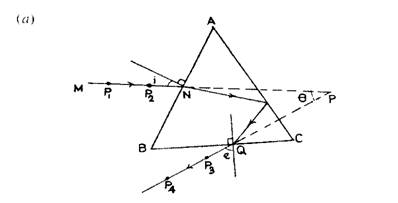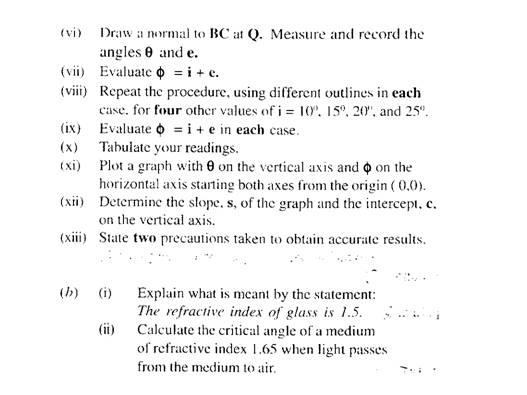Question 2B

Using the diagram above as a guide:
(i) Trace the outline ABC of the equilateral triangular glass
prism provided.
(ii) Remove the prism. Draw a line MN such that it makes
an angle i = 5° with the normal at N on side AB of the
outline.
(iii) Fix two pins at PI and P2 on MN. Replace the prism
on its outline.
(iv) Looking through the face BC of the prism, fix one pin
at P3 and another at P4 such that they are in a straight
line with the images of the pins at PI and P 2'
(v) Remove the prism and the pins. Draw a line to join P4
and P3. Produce line P4P3 to meet the line BC of the
outline at Q and line MN produced at P.

Observation
Part (a). This question was not popular among the candidates. Candidates were challenged in making traces as requires. They also exhibited poor knowledge in measuring angles θ, ![]() due to
due to
poor handling of protractor but they were able to evaluate θ . Some candidates did not attach their traces while some had traces without pin marks indicating that the experiment was not actually performed. However, they were able to plot the graph and determine the slope.
Part (b). This part were not satisfactorily answered by majority of the respondent.
Candidates were expected to
- Draw five complete traces showing at least incident ray, emergent ray,
from face BC, the normal at N and Q and the intersection of the incident
and emergent rays)
- Measure and record five values of ![]() measured and recorded in degrees and in trend.
measured and recorded in degrees and in trend.
Trend: as i increases, e increases.
- Measure and record five values of θ to at least 1 d.p in degrees and in trend.
Trend: as i increases, decreases.
- Evaluated five values of ![]() = i + e
= i + e
- List i![]() . in a composite table
. in a composite table
- Distinguish both axes
- Plot graph using appropriate scales
- Draw line of best fit
- Evaluate slope and intercept
- State any two of the following precautions.
Ensured pins were vertical / erect
Sharp pencil/neat traces (seen from traces)
Reasonable spacing of pins (about 4cm apart)
Avoided parallax error in reading protractor
Repeated readings shown on the table
The expected answers for part (b) are:
b(i) Whenever light travels from air to glass, the ratio of the sine of the angle of incidence to
the sine of the angle of refraction is 1.5[2]
OR
Velocity of light in air is 1.5 times greater than the velocity of light in glass.
OR
n = ![]() = 1.5
= 1.5
(ii) n = refractive index
n = ![]()
OR
C = sin-1![]() )
)
= sin-1![]()
